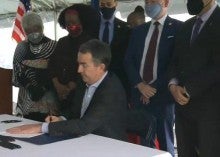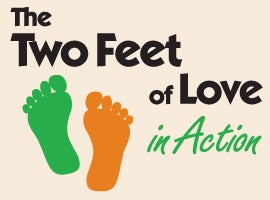How to Make Service Truly Transformational
We can sometimes have a tendency to view service projects as isolated events that start upon arrival at the service site and end upon exit. This tendency can mean a missed opportunity to make service truly transformational for both those who serve and for those served. Interested in how to make service transformational? Then read on. There’s a tried and true process for service called Act, Reflect, Transform that can help you make the most of service!
Act
“Act” refers to the charitable works we perform through service projects. When planning a service project, here are some things to think about. The ideal service project will provide an opportunity for face-to-face interaction with members of the human family in need. While cleaning up litter or sorting food at the local pantry are good things to do, these types of projects also offer little potential for true transformation. The truth is that nothing can replace the experience of real interaction and relationship with real, living human beings. Just think about it: isn’t it easier to see the “face of Christ” in a homeless family at a soup kitchen or child at a tutoring program than in beneficiaries who are not seen or met?
Second, choose a service project that leads to the empowerment of those served, with an emphasis on doing with and walking alongside instead of doing for. In other words, choose a service project that affirms the dignity of those being served, and which does not encourage an “us” vs. “them” mentality. Groups that are funded by the Catholic Campaign for Human Development make excellent service sites because of their emphasis on the empowerment of poor and low-income people to make a difference in their own communities.
Third, the service project should include structured opportunities for being in addition to doing. At a homeless shelter, volunteers might be responsible for preparing and serving meals. Paired with this “doing” part of the project, there should also be time for the volunteers to sit down at a table in the model of Christ and to eat and converse with those in need (i.e. “being). For example, upon advance request, the director of the shelter may be able to arrange a structured opportunity for volunteers to hear the stories of some of the homeless individuals. The experience is sure to be meaningful for all parties involved.
Reflect
Many people have the mistaken impression that service ends after leaving the service site. This is far from the truth! Failing to follow up with reflection after service is one of the most common lost opportunities in service.
First, we must remember that service, as everything we do, must be rooted in prayer. Prayer is essential for many reasons, the most obvious of which is because we believe that God will be able to make a difference in the lives of those served. It also provides a powerful reflective space to help volunteers begin to process their experience and to listen for the response to which they may be called.
A second essential part of the “reflect” element of service is to facilitate the asking of “why” questions about the causes of the problems confronted in service. Why do people become homeless? Why aren’t children in some parts of the city receiving an adequate education? This part of reflection includes questions and discussion about the underlying causes of unjust situations, about human relationships, beliefs and values, and personal and social responsibility.
Our job as leaders is to first help volunteers ask these questions, and then to suggest how Scripture and the Church’s teachings shine a unique light on the issues. We can begin by asking simple questions, such as “Where is God present?” or “Where is the “face of Christ’ present?” But to stop here is insufficient. As leaders, we must introduce volunteers to the Catholic social teachings—an essential part of any service program. Often called the “best-kept secret” of the Church, the sad truth is that many who have gone through years of Catholic education still do not know that the Church possesses a rich body of teachings which shine an “unchanging light” on the “new problems that are constantly emerging” in our world (Pope Benedict XVI, Caritas in Veritate, no. 12). If you’re saying to yourself at this moment, “But I don’t know much about Catholic social teaching myself, how can I teach others?”, don’t let this stop you! There’s no better time than now to learn more. Find out more about the social teachings of the Church by visiting the website of the USCCB Department of Justice, Peace and Human Development.
Ideally, reflection around service projects is not the first time that volunteers should be hearing about Catholic social teaching, since action for justice is a “constitutive dimension” of our faith. Service is the ideal place for this teaching to truly take wings, but it is only the starting point; the reflection that follows, ideally in a facilitated, small-group setting, is what takes the person-to-person interaction during service to the next level, offering the opportunity for critical reflection in the light of our faith that is essential to the formation of life-long, faithful citizens.
Transform
The third step of the model is “Transform.” Interaction with the vulnerable through service followed by new questions and learning during reflection must lead to work to transform all of society.
The ideal service project will be paired with opportunities for advocacy and efforts to transform unjust structures. This includes considering what action is needed to address the root causes of the situation encountered during service. Action for transformation aims to address systemic, structural injustice, and changing values and policies that are in need of transformation or renewal.
The Compendium of the Social Doctrine of the Church, published by the Vatican in 2004, reminds us: “It is undoubtedly an act of love, the work of mercy by which one responds here and now to a real and impelling need of one's neighbor, but it is an equally indispensable act of love to strive to organize and structure society so that one's neighbor will not find himself in poverty” (no. 208). The first step of the model, “Act,” focused on responding to the “here and now” needs, while the third step, “Transform,” focuses on striving to reorganize society.
An essential distinction for any service leader to keep in mind is that between “Charitable Works” and “Social Justice,” called the “Two Feet of Love in Action.” Charitable works such as those performed by young people during service help individuals meet their immediate needs. When we serve in soup kitchens, donate food, clothing or money, tutor or mentor children, or sponsor a refugee family, we are performing charitable works. The second “foot” of social action, “social justice,” aims to correct long-term problems in communities. Advocating for just public policies and becoming involved in community self-help projects are examples of social justice.
Both feet of social action are needed: Pope Pius XI highlighted the distinction between the two feet of social action over 70 years ago: "Charity will never be true charity unless it takes justice into account ... Let no one attempt with small gifts of charity to exempt himself from the great duties imposed by justice" (Divini Redemptoris, 49). In a similar way, in Caritas in Veritate, Pope Benedict XVI notes that both direct encounter with neighbor and work for justice are necessary (7).
Thus, service projects must lead volunteers, in this final step, to consider their role in transforming society, with all its policies and structures, with the intent to eliminate the causes of injustice—to end the need for soup kitchens, homeless shelters, and tutoring programs.
In this part of the model, volunteers should create a plan to help transform the world for justice—for example, by writing letters to their congresspersons, educating others, or joining a local advocacy effort related to the issues addressed in service. For example, to address homelessness, volunteers might advocate in support of funding for job training programs or affordable housing for low-income people.
True interaction with the face of Christ in those in need should also leave every volunteer transformed on the personal level. In addition to taking action to help transform society, volunteers should also be encouraged to identify changes they can make in their lifestyles, daily decisions, and worldviews in order to better live out their faith in the day-to-day through greater solidarity with others in need in their communities and world.
“Act, Reflect, Transform” is a simple process that, when implemented, has the potential to lead to a real and sustained desire to live one’s faith and to work for the transformation of the world in need. The model is flexible enough to be implemented in a variety of ways. A leader organizing a service project for a group can bring participants together afterward for a period of reflection and transformation. In a situation where individual volunteers are completing service projects on their own, the model can still be implemented through a reflection evening when everyone gathers to “reflect” together on their service experiences, learn about CST, and ask the “why” questions, and to consider how they might be called to “transform” our world into a more just place.
This article is an adaptation of the original article, “From warm and fuzzy to transformational: Taking service projects to the next level,” in Formed magazine, by Jill Rauh, who is now the Director of Education and Outreach for the USCCB Department of Justice, Peace and Human Development.


